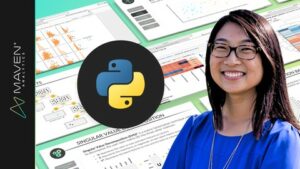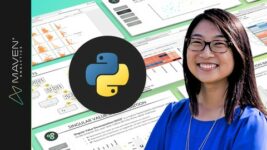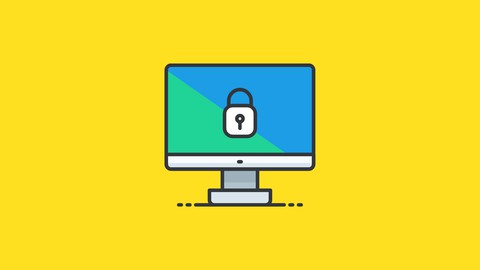Python Data Science: Unsupervised Machine Learning

Learn Python for data science & machine learning, and build unsupervised learning models w/ a top Python instructor!
Product Brand: Udemy
4.7
Udemy Coupon Code for Python Data Science: Unsupervised Machine Learning Course. Learn Python for data science & machine learning, and build unsupervised learning models w/ a top Python instructor!
Created by Maven Analytics, Alice Zhao | 16.5 hours on-demand video course
Python Data Science Course Overview
Python Data Science: Unsupervised Machine Learning
This is a hands-on, project-based course designed to help you master the foundations for unsupervised learning in Python.
We’ll start by reviewing the data science workflow, discussing the techniques & applications of unsupervised learning, and walking through the data prep steps required for modeling. You’ll learn how to set the correct row granularity for modeling, apply feature engineering techniques, select relevant features, and scale your data using normalization and standardization.
From there we’ll fit, tune, and interpret 3 popular clustering models using scikit-learn. We’ll start with K-Means Clustering, learn to interpret the output’s cluster centers, and use inertia plots to select the right number of clusters. Next, we’ll cover Hierarchical Clustering, where we’ll use dendrograms to identify clusters and cluster maps to interpret them. Finally, we’ll use DBSCAN to detect clusters and noise points and evaluate the models using their silhouette score.
We’ll also use DBSCAN and Isolation Forests for anomaly detection, a common application of unsupervised learning models for identifying outliers and anomalous patterns. You’ll learn to tune and interpret the results of each model and visualize the anomalies using pair plots.
Next, we’ll introduce the concept of dimensionality reduction, discuss its benefits for data science, and explore the stages in the data science workflow in which it can be applied. We’ll then cover two popular techniques: Principal Component Analysis, which is great for both feature extraction and data visualization, and t-SNE, which is ideal for data visualization.
Last but not least, we’ll introduce recommendation engines, and you’ll practice creating both content-based and collaborative filtering recommenders using techniques such as Cosine Similarity and Singular Value Decomposition.
Throughout the course you’ll play the role of an Associate Data Scientist for the HR Analytics team at a software company trying to increase employee retention. Using the skills you learn throughout the course, you’ll use Python to segment the employees, visualize the clusters, and recommend next steps to increase retention.
What you’ll learn
- Master the foundations of unsupervised Machine Learning in Python, including clustering, anomaly detection, dimensionality reduction, and recommenders
- Prepare data for modeling by applying feature engineering, selection, and scaling
- Fit, tune, and interpret three types of clustering algorithms: K-Means Clustering, Hierarchical Clustering, and DBSCAN
- Use unsupervised learning techniques like Isolation Forests and DBSCAN for anomaly detection
- Apply and interpret two types of dimensionality reduction models: Principal Component Analysis (PCA) and t-SNE
- Build recommendation engines using content-based and collaborative filtering techniques, including Cosine Similarity and Singular Value Decomposition (SVD)
Recommended Python Data Science Course
ChatGPT for Python Data Science and Machine Learning
ChatGPT for Python Data Science and Machine Learning
Welcome to the first Data Science and Machine Learning course with ChatGPT. Learn how to use ChatGPT to master complex Data Science and Machine Learning real-life projects in no time! Real-world Data Science and Machine Learning projects require a solid background in advanced statistics and Data Analytics. And it would be best if you were a proficient Python Coder. Do you want to learn how to master complex Data Science projects without the need to study and master all the required basics (which takes dozens if not hundreds of hours)? Then this is the perfect ChatGPT for Python Data Science and Machine Learning course for you!
Python Data Science: Data Prep & EDA with Python
Python Data Science: Data Prep & EDA with Python
This is Python Data Science: Data Prep & EDA with Python hands-on, project-based course designed to help you master the core building blocks of Python for data science. We’ll start by introducing the fields of data science and machine learning, discussing the difference between supervised and unsupervised learning, and reviewing the data science workflow we’ll be using throughout the course.
From there we’ll do a deep dive into the data prep & EDA steps of the workflow. You’ll learn how to scope a data science project, use Pandas to gather data from multiple sources and handle common data cleaning issues, and perform exploratory data analysis using techniques like filtering, grouping, and visualizing data.
Who this course is for
- Data scientists who want to learn how to build and interpret unsupervised learning models in Python
- Analysts or BI experts looking to learn about unsupervised learning or transition into a data science role
- Anyone interested in learning one of the most popular open source programming languages in the world
Best Data Science in Python Course for 2024
Data Science in Python: Classification Modeling Featured
Data Science in Python: Regression & Forecasting Best seller
Taught by Alice Zhao









